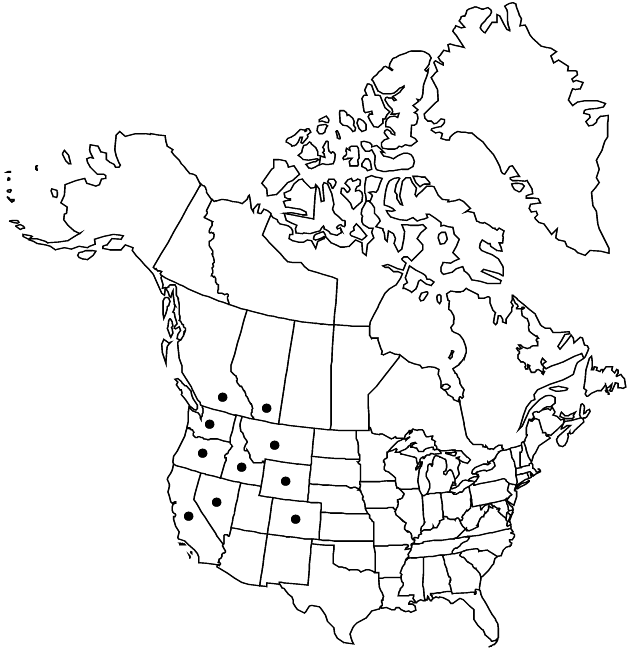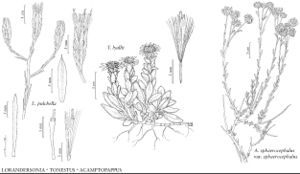Tonestus lyallii
Bot. Gaz. 37: 262. 1904.
Perennials, loosely cespitose, 4–8.5 (–15) cm; with branched caudices surmounting poorly developed taproots, or short rhizomes. Stems glabrous, densely stipitate-glandular. Leaves: basal blades linear to spatulate, 30–85 × 3–12 mm; cauline blades oblong to broadly lanceolate, 12–37 × 3–9 (–12) mm, gradually reduced distally; 3–5-nerved, margins entire, eciliate, stipitate-glandular, faces stipitate-glandular. Peduncles 2–5 mm. Heads 1 (–2). Involucres broadly campanulate, 11–22 × 8–11 mm. Phyllaries 18–42, in 3–4 (–5) series,, 1-nerved or weakly 3-nerved, ± equal, margins eciliate; outer and mid oblong to broadly lanceolate, 5.2–9.5 × 1–3.5 mm, stipitate-glandular, apices acute; inner green or anthocyanic, linear, 8–13 × 1–2 mm, chartaceous proximally, margins scarious, fimbriate and/or stipitate-glandular distally, apices acute to acuminate, sometimes reflexed, faces stipitate-glandular distally. Ray-florets 11–23; laminae elliptic, 6.5–8 × 1–3.5 mm. Disc-florets 27–56; corollas narrowly funnelform, 5.5–8.5 mm, scarcely exceeding involucres, lobes erect to spreading, 0.6–0.8 mm, lengths 1/10–1/5 corollas; anthers 2–2.5 mm; style-branch appendages lanceolate, 0.7–1 × 0.2–0.3 mm, stigmatic lines 0.9–1.4 mm. Cypselae linear, 2.5–5.5 mm, 8–12-nerved, faces glabrous or sparsely hairy distally; pappus bristles 35–52, flexible. 2n = 18.
Phenology: Flowering and fruiting early–late summer.
Habitat: Meadows, fellfields, talus slopes, rock crevices, open coniferous forests in alpine and subalpine communities, on soils usually of granitic, sometime of limestone or shale origin
Elevation: 1500–3800 m
Distribution

Alta., B.C., Calif., Colo., Idaho, Mont., Nev., Oreg., Wash., Wyo.
Discussion
Tonestus lyallii is widespread in the central Rocky Mountains and ranges of the Pacific Northwest, and is known in the Great Basin from collections in the Ruby Mountains in Elko County, Nevada. Populations documented from the Coast Range in Siskyou and Trinity counties, California, are disjunct from those in Oregon and Washington by more than 700 km.
Selected References
None.
